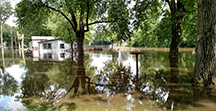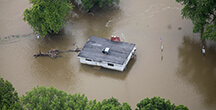Homeowners: Make sure house is dried out before repairing
July 6, 2015
 |
|
The Tippecanoe River in northwestern Indiana swelled over its banks in mid-June, flooding dozens of homes in and near Buffalo in White County, including this one. (Purdue Agricultural Communication photo/Steve Cain) |
WEST LAFAYETTE, Ind. - Homeowners wanting to repair their flood-damaged home should wait until the wood and other materials dry out enough so they don't cause more problems later, such as with mold, a Purdue Extension disaster education specialist says.
Renovating too soon could trap moisture in wood, leading to rotting and promoting growth of mold, noted Steve Cain, who said it could take weeks to dry out a house to the point where repairs can be made.
Submerged wood can absorb a large amount of water. If enough moisture is trapped in the wood, mold is likely to grow behind walls and may cause serious health problems in the near or long term for people who live in the house.
"With the duration of the rains this year, people are anxious to rebuild the areas of their home that were flooded," he said. "But they need to step back and make sure the home is dry enough to rebuild."
 |
|
The Wabash River over its banks on July 2 northeast of Lafayette, Indiana, looking to the southwest. The N. Ninth Street bridge in the photo connects Lafayette, at left, to Battle Ground. (Purdue Agricultural Communication photo/Tom Campbell) |
Cain said Purdue Extension staff get calls months after a flood from homeowners who find that they have large amounts of mold in the walls. That is because they didn't wait for the wooden studs in the wall to dry out before remodeling.
"Putting insulation and wall board up before the studs are dry traps moisture in the wall. Adding the insulation and wall board feeds mold growth, which often occurs months down the road from the flood," he said.
Homeowners starting a repair project should remove wall and floor coverings exposed to floodwaters, Cain said. That includes sheet rock, insulation, carpeting and possibly linoleum paneling or the subflooring.
Fans and dehumidifiers can help ventilate wet material and remove moisture from the air.
 |
|
A flooded house on the north side of the Wabash River, south of West Lafayette, Indiana. (Purdue Agricultural Communication photo/Tom Campbell) |
Before drywall, paneling or other coverings are installed, wood should have a moisture content of less than 15 percent. Homeowners may be able to borrow or rent a moisture meter from a hardware store or lumberyard.
"For the cost of a $20 moisture meter that is available at most hardware stores or on-line, you can save tens of thousands of dollars on mold remediation down the road," Cain said.
For severe flooding, homeowners might want to have a building inspector or a professional, trustworthy contractor inspect the wood before rebuilding, Cain said.
For more information, the Extension Disaster Education Network has resources for owners of flood-damaged homes in the publication First Steps to Flood Recovery, available free for download at Extension's The Education Store at www.edustore.purdue.edu. Search for product code ACS-101-W.
Writer: Keith Robinson, 765-494-2722, robins89@purdue.edu
Source: Steve Cain, 765-494-8410, cain@purdue.edu
Ag Communications: (765) 494-2722;
Keith Robinson, robins89@purdue.edu
Agriculture News Page

